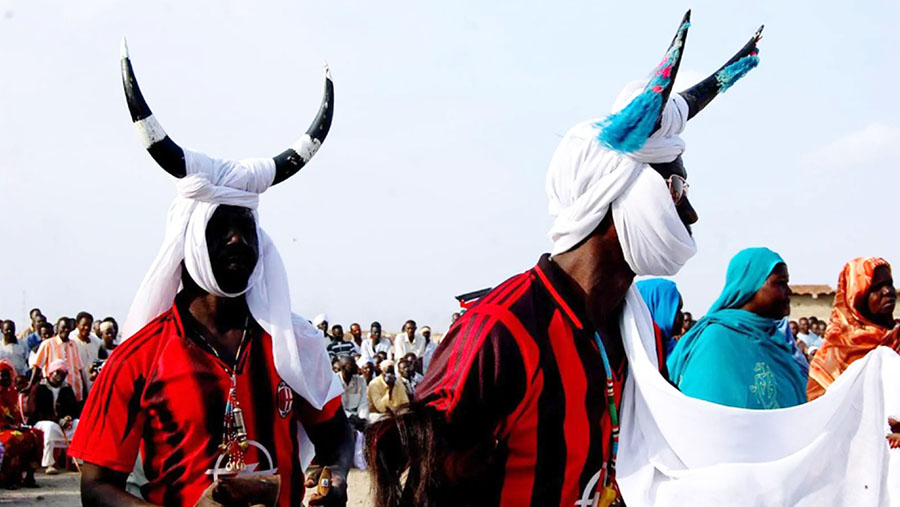
``Harvest Festivals``: Messages of Peace Defying the Machinery of Death in Sudan
Source: Independent Arabia
Despite the grim realities and tragedies of war, Sudanese people continue to organize cultural events and celebrate traditional festivals. The echoes of art and music still resonate from time to time, reminding everyone of the countrys rich heritage and folklore as a form of human resistance to the armed conflict and harsh conditions. This resilience is exemplified in the Nuba Mountains, west of Khartoum, where the Harvest Festival is celebrated for an entire week.
The festival aims to foster coexistence among the diverse cultural groups through traditional arts and dances. It also serves as a call for peace and an end to the fighting in Sudan. The festivities feature dances like Nogara, Karang, and Kambala, as well as spirited rhythms and wrestling competitions, a beloved sport in Nuba Mountain communities.
Unique Beliefs
The harvest season spans from mid-September to December, during which young farmers begin reaping the seasons crops, accompanied by rituals such as Sabir Al-Lubia or Sabir Al-Natal.
On the festival’s first day, assistants to the Kujur (a spiritual figure akin to a priest) inspect the agricultural areas to confirm the ripeness of the crops and then announce the start of the harvest season. In the evening, the community celebrates the Kujurs emergence from his seclusion in a mountain hut, where he had stayed for four months during the rainy season.
The Kujurs reappearance coincides with young men and women choosing their life partners atop the mountain. Harvest time in the Nuba Mountains is also marked by solidarity, as food staples like sorghum and millet are distributed to displaced people fleeing the devastation of war. This generosity is especially significant as the residents of South Kordofan State struggle with famine caused by blockades imposed by the Rapid Support Forces and the Sudan People’s Liberation Movement-North.
Messages of Peace
According to Khamees Koko, a researcher of Nuba heritage, the Harvest Festival sends powerful messages advocating peace and an end to violence across all regions of Sudan. “The various forms of art play a critical role in alleviating tensions and amplifying the melodies and dances over the sounds of weapons. These are messages of hope and trust that Sudan can emerge from its dark tunnel,” he said.
Koko added that singing and celebrating amidst the current circumstances represent acts of defiance against the machinery of death and a departure from sorrow and economic hardship.
He highlighted that the Nuba people displayed expressive performance arts with the community participating according to age groups. Men danced separately from women to the rhythm of Irshad, a slow and characteristic musical beat unique to the region, symbolizing unity and camaraderie.
Koko also noted other traditional practices, such as young men carrying traditional weapons like spears, knives, and small axes for self-defense. Meanwhile, women adorned themselves with jewelry made of gold, silver, and local ornaments known as Turabulul.
Traditional Wrestling
The festival’s second day featured a sporting event called Siraa, similar to freestyle wrestling, deeply rooted in the cultural and social fabric of the region. Held during harvest season, this annual competition attracts large crowds.
The matches pit wrestlers from different tribes against each other in a ring, accompanied by a local referee known as the Sibari, who enforces the rules. The competition ends when one wrestler is thrown to the ground in a move called Ardamia (or “the fall”), with victory going to the most skilled and physically strong participant.
One of the largest wrestling arenas in the Nuba Mountains is the Natal arena west of Dilling City, where the festivities commence with Sabir Al-Lubia.
Evening activities feature traditional dances such as Karang, Kambala, and Nagara. In Nagara, women stand upright with hands on their hips, stamping their right foot and moving forward. Men perform with sticks, advancing and retreating gracefully. In Kambala, young women form a semi-circle, singing, while young men enter the stage adorned with feathers, bells, and colorful garments, showcasing their dance skills.
A Bridge to Unity
Sharif Hassan Teih, a member of the Nuba Heritage Center for Culture and Arts, explained that Siraa fosters a sense of triumph and psychological peace, preventing rival factions from engaging in combat. “During the celebrations, ethnic and cultural differences between tribes vanish, and social harmony prevails while preserving the diverse heritage of the Nuba people,” he said.
He added that art helps ease tensions among communities and serves as a unifying force in Sudanese national and popular consciousness.
Teih noted that Nuba communities teach children to farm early, starting with small backyard plots called Jibraka. This instills responsibility and allows them to contribute to family food security, preparing them for work on larger agricultural projects.
Marriage Rituals
Marriage customs accompany the Harvest Festival, where young men choose their brides. According to researcher Taher Suleiman, communities in the Nuba Mountains celebrate successful harvests and the beginning of the new crop season with the Sabir Al-Lubia tradition. This practice is common among the Koglu Tangara, the mountain valley residents belonging to one of the ten linguistic groups comprising the Nuba people.
Young men prepare songs to perform for their peers in other villages as a rite of passage from bachelorhood to marriage.
Before marriage celebrations, young men engage in whip duels using goat hide and tree bark called Turn Kiso. The winner receives a pottery vessel called Kato.
Finally, the celebrations culminate with a dance known as Tenkli, symbolizing the transition of young men into adulthood. At the conclusion of the festival, the tribe gifts newlyweds livestock and jewelry as wedding presents.

